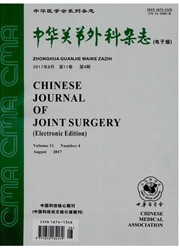

 中文摘要:
中文摘要:
目的探讨股骨粗隆间骨折患者行闭合复位内固定治疗后前倾角改变对其步态的影响。方法回顾性分析2013年11月至2016年3月,广东省顺德区第二人民医院骨科收治的55例行单侧内固定手术的股骨粗隆间骨折患者,治疗方法为闭合复位内固定手术,测量双侧骨折愈合后股骨颈前倾角,观察对比患者正常侧步态及双侧步态情况,比较手术后股骨前倾角改变对步态的影响。采用SPSS 20.0软件对数据行t检验。结果 55例单侧股骨粗隆间骨折行闭合复位内固定术患者,其中动力髋螺钉(DHS)内固定28例,股骨近端防旋髓内钉(PFNA)内固定27例,均获得良好骨性愈合。DHS组患者患侧股骨前倾角(11.6±2.2)°,健侧前倾角(12.5±2.4)°;PFNA组患者患侧前倾角(12.2±2.6)°,健侧前倾角(13.1±1.6)°。两组患者手术后前倾角的比较差异无统计学意义(P〉0.05);两组患者步态分析差异无统计学意义(P〉0.05)。结论股骨粗隆间骨折患者,术后前倾角改变对步态无明显影响。
 英文摘要:
英文摘要:
Objective To investigate the effects of the anteversion angle changes on the gait in the patients of intertrochanteric fractures. Methods A retrospective analysis was carried out on the patients admitted to the Department of orthopedics, Second People's Hospital of Shunde District, from November 2013 to March 2016. A total of 55 cases of intertrochanteric fractures were treated by unilateral internal fixation with closed reduction; the femoral neck anteversion was measured after the fracture healing. The gaits of normal side and the involved side were observed and compared to analyse the effect of femoral anteversion change on gait. The angles during walking and anteversion angles were analysed by t test with SPSS 20. 0. Results All the 55 cases of unilateral intertroehanteric fractures were treated with closed reduction and internal fixation, including dynamic hip screw (DHS) internal fixation in 28 cases and proximal femoral nail anti-rotation (PFNA) internal fixation. A good bone healing was achieved in all the cases. The patients of DHS had a femoral anteversion of ( 11.6 ± 2. 2 ) ° , while the femoral anteversion of the healthy side was ( 12. 5 ± 2.4 ) °. The patients of PFNA had femoral anteversion of ( 12. 2 ± 2. 6 ) °, while the anteversion of the healthy side was ( 13. 1 ± 1.6)°. No significant difference was found in the anteversion between the DHS patients and PFNA patients after the operation ( P 〉 0. 05 ) ; the gait analysis showed no significant difference between the DHS patients and PFNA patients ( P 〉 0. 05 ). Conclusion The changes of the anteversion angle in the patients of intertrochanteric fracture would not affect the gait after the surgery.
 同期刊论文项目
同期刊论文项目
 同项目期刊论文
同项目期刊论文
 期刊信息
期刊信息
